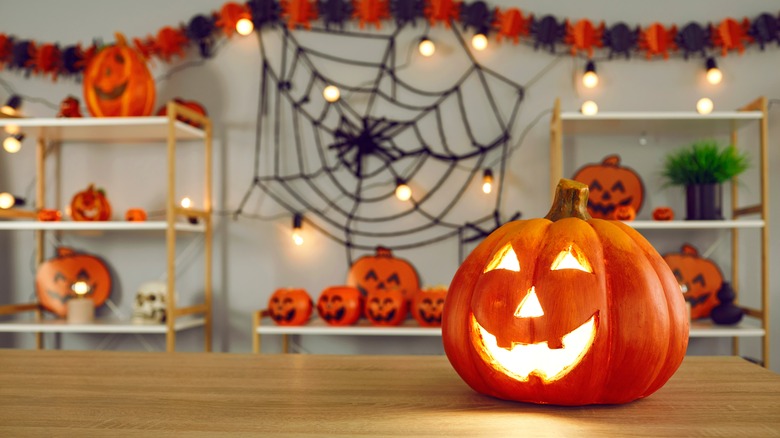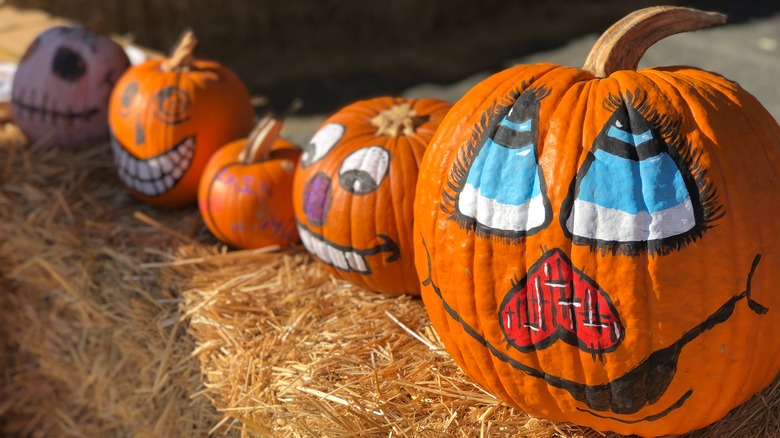How To Ensure Your Jack-O'-Lanterns Last Longer
Now that Halloween has come and gone, it may be a good time to ponder how to make next year's crop of jack-o'-lanterns last longer than this year's. Although an intact pumpkin can last several months, it'll start rotting within days after carving it (per Realtor.com). Thus, expect your gourd art to be ephemeral. However, there are still a number of ways to forestall the inevitable before your creation becomes shriveled, stinky, and soft.
The first key to jack-o'-lantern longevity is spotting the perfect pumpkin to grace with your blade. That being said, don't carve it until the last minute if you want it to look its best on Halloween night. You'll also want to keep the fruit cool until it's cut, then avoid any temperature extremes. Be sure to prevent dehydration, but try to avoid wet, mold-promoting conditions as well. A variety of disinfectants and preservatives are useful in slowing deterioration. Even so, an outdoor jack-o'-lantern will require protection from interested animals, so be on guard if leaving your grinning friend outside. According to Smithsonian Magazine, traditional candles also shorten their lifespan and should be substituted with efficient LED lights if possible.
Pick and prepare your pumpkin
A long-lasting jack-o'-lantern is apt to be the spawn of a robust pumpkin. Try to pick the perfect specimen from a patch or farm stand, and aim for a hard rind, lack of bruises, and the absence of pinholes from hungry eaters. Keep in mind a long green stem provides the most nutrients and is almost always a reliable sign of a healthy fruit.
The New York Times Wirecutter recommends carving a minimum of holes and making them as shallow as possible. Cutting from the top weakens the structure and encourages decomposition, so it should be entered from the bottom or back to allow a light to be inserted. However, make sure to close the opening as soon as possible in order to stave off decomposition. A lit candle will dry the pumpkin out, hastening the rotting process. Good alternatives to traditional candles are battery-powered lights or glow sticks.
After carving, Farmers' Almanac suggests spraying all cut surfaces and the fruit's interior with a solution of water and bleach in order to prevent mold and rot. On the other hand, if you live in a dry area, Vaseline can be smeared around carved areas to aid moisture retention. Sugar, salt, vegetable oil, and peppermint are non-toxic substances that can also be employed as pet-friendly choices to protect your pumpkin.
Protect your jack-o'-lanterns from animals and decay
In the mood for a science experiment? Mom Hacks 101 conducted a test of household products praised on the Internet for preserving jack-o'-lanterns and found bleach to be the clear-cut winner. A bleach bath kept mold at bay for nine days, while mouthwash performed the worst and even attracted numerous insects. Moisture is a catalyst for decomposition, and Farmers' Almanac outlines a routine for keeping your Halloween artwork as dry as possible. Going through the bottom or the back, scoop out all seeds and pulp. Next, scrape the interior walls and leave them as smooth as possible. Doing so will eliminate any nooks and crannies where water might collect. Finally, wipe the interior dry with a paper towel.
Squirrels, chipmunks, and deer are fond of pumpkins, and Miami Herald has several suggestions for protecting outdoor Halloween displays. Sprinkling cayenne pepper or fortifying them with clumps of pet hair might do the trick, as will utilizing a dab or two of hot sauce. If you happen to have an owl statue, have it stand guard next to your jack-o'-lanterns.
Of course, painting a face on a pumpkin will result in an exceptionally resilient jack-o'-lantern, albeit one without the lantern (per Martha Stewart). However, photographing your custom creation will preserve it for many Halloweens to come!


